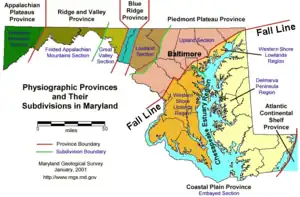Portal:Maryland
|
Maryland Portal |
Baltimore Task Force |
Frederick Task Force |
Montgomery Task Force |
WikiProject Maryland |
|
Main page |
Discussion |
Introduction Maryland (US: /ˈmɛrɪlənd/ ( Before its coastline was explored by Europeans in the 16th century, Maryland was inhabited by several groups of Native Americans – mostly by Algonquian peoples and, to a lesser degree, Iroquoian and Siouan. As one of the original Thirteen Colonies of England, Maryland was founded by George Calvert, 1st Baron Baltimore, a Catholic convert who sought to provide a religious haven for Catholics persecuted in England. In 1632, Charles I of England granted Lord Baltimore a colonial charter, naming the colony after his wife, Henrietta Maria. Unlike the Pilgrims and Puritans, who rejected Catholicism in their settlements, Lord Baltimore envisioned a colony where people of different religious sects would coexist under the principle of toleration. Accordingly, in 1649 the Maryland General Assembly passed an Act Concerning Religion, which enshrined this principle by penalizing anyone who "reproached" a fellow Marylander based on religious affiliation. Nevertheless, religious strife was common in the early years, and Catholics remained a minority, albeit in greater numbers than in any other English colony. Maryland's early settlements and population centers clustered around rivers and other waterways that empty into the Chesapeake Bay. Its economy was heavily plantation-based and centered mostly on the cultivation of tobacco. Demand for cheap labor from Maryland colonists led to the importation of numerous indentured servants and enslaved Africans. In 1760, Maryland's current boundaries took form following the settlement of a long-running border dispute with Pennsylvania. Maryland was an active participant in the events leading up to the American Revolution, and by 1776, its delegates signed the Declaration of Independence. Many of its citizens subsequently played key political and military roles in the war. In 1790, the state ceded land for the establishment of the U.S. capital of Washington, D.C. (Full article...)
| ||||
 Charles Carroll the Settler |
Charles Carroll (1661–1720), sometimes called Charles Carroll the Settler to differentiate him from his son and grandson, was a wealthy lawyer and planter in colonial Maryland. Carroll, a Catholic, is best known because his efforts to hold office in the Protestant-dominated colony (of Maryland) resulted in the disfranchisement of the colony's Catholics.
The second son of Irish Catholic parents, Carroll was educated in France as a lawyer before returning to England, where he pursued the first steps in a legal career. Before that career developed, he secured a position as Attorney General of the young colony of Maryland. Its founder George Calvert and his descendants intended it as a refuge for Catholics. (Full article...)General images
In the news
- November 1, 2007 - Westboro Baptist Church ordered to pay US$11 million to family of fallen US soldier
- September 30, 2007 - Interview with gay marriage movement founder Evan Wolfson
- September 1, 2007 - Four jackpot winners confirmed in US 'Mega Millions' lottery drawing
- May 20, 2007 - Horse racing: Curlin wins 2007 Preakness Stakes
On this day...
The Maryland portal currently doesn't have any anniversaries listed for May 16. You can help by viewing the page source of an existing entry at /On this day to see how the entries should be formatted, then adding the missing entry.
 Good article -
Good article -
 Keeler in 1996 |
William Henry Keeler (March 4, 1931 – March 23, 2017) was an American cardinal of the Catholic Church. He served as Archbishop of Baltimore, Maryland, from 1989 to 2007 and was elevated to the College of Cardinals in 1994. He previously served as Auxiliary Bishop and Bishop of the Diocese of Harrisburg. Keeler was President of the United States Conference of Catholic Bishops from 1992 to 1995.
As Archbishop of Baltimore, Keeler led a restoration of the Basilica of the National Shrine of the Assumption of the Blessed Virgin Mary, one of two cathedrals in the archdiocese and the oldest in the United States, which was completely repaired and restored to near its original appearance by 2006. Keeler was also recognized for forming strong relationships with people from other religious groups, particularly those of the Jewish and Protestant faiths. He was also noted for his response to the sexual abuse crisis in the Catholic Church, choosing to publish the names of 57 priests who had been "credibly accused of child abuse" in 2002. In 2018, however, it was said he had not taken action against priests who had been accused of inappropriate conduct, significantly damaging his reputation. (Full article...)Selected article -

Did you know?
- ...that unlike most other American courts, the judges on the Maryland Court of Appeals wear crimson (not black) robes, and neck bands, reminiscent of British court dress?
- ...that Kent Island was founded in 1631 as part of Virginia, three years before St. Mary's City was founded?

- ...that the Thomas Viaduct (pictured) over the Patapsco River was the first multi-span masonry railroad bridge in the United States when it was constructed between 1833 and 1835?
Subcategories
Topics
Related portals
Associated Wikimedia
The following Wikimedia Foundation sister projects provide more on this subject:
-
 Commons
Commons
Free media repository -
 Wikibooks
Wikibooks
Free textbooks and manuals -
 Wikidata
Wikidata
Free knowledge base -
 Wikinews
Wikinews
Free-content news -
 Wikiquote
Wikiquote
Collection of quotations -
 Wikisource
Wikisource
Free-content library -
 Wikiversity
Wikiversity
Free learning tools -
 Wikivoyage
Wikivoyage
Free travel guide -
 Wiktionary
Wiktionary
Dictionary and thesaurus
-
 List of all portalsList of all portals
List of all portalsList of all portals -
 The arts portal
The arts portal -
 Biography portal
Biography portal -
 Current events portal
Current events portal -
 Geography portal
Geography portal -
 History portal
History portal -
 Mathematics portal
Mathematics portal -
 Science portal
Science portal -
 Society portal
Society portal -
 Technology portal
Technology portal -
 Random portalRandom portal
Random portalRandom portal -
 WikiProject PortalsWikiProject Portals
WikiProject PortalsWikiProject Portals











.jpg.webp)

.svg.png.webp)


















.svg.png.webp)